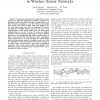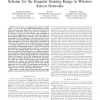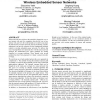22 search results - page 2 / 5 » Run to Potential: Sweep Coverage in Wireless Sensor Networks |
GLOBECOM
2010
IEEE
13 years 3 months ago
2010
IEEE
Constructing sensing barriers using wireless sensor networks has important applications in military operations and homeland security. The goal of forming a sensing barrier is to de...
GLOBECOM
2006
IEEE
13 years 11 months ago
2006
IEEE
— Coverage is an important issue related to WSN quality of service. Several centralized/decentralized solutions based on the geometry information of sensors and under the assumpt...
SENSYS
2003
ACM
13 years 10 months ago
2003
ACM
Sensor networks not only have the potential to change the way we use, interact with, and view computers, but also the way we use, interact with, and view the world around us. In o...
IJSNET
2006
13 years 5 months ago
2006
: To extend the functional lifetime of battery-operated Wireless Sensor Networks (WSNs), stringent sleep scheduling strategies with communication duty cycles running at sub-1% rang...
ICSAP
2010
13 years 9 months ago
2010
— When sensors are redundantly deployed, a subset of sensors should be selected to actively monitor the field (referred to as a "cover"), while the rest of the sensors ...



